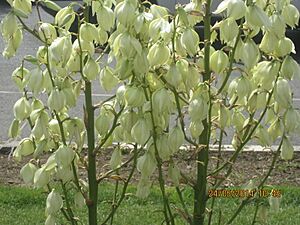Yucca gloriosa facts for kids
Quick facts for kids Yucca gloriosa |
|
|---|---|
 |
|
| Long-trunked Spanish Dagger | |
| Conservation status | |
| Scientific classification | |
 |
|
| Natural range | |
| Synonyms | |
|
Species synonymy
Yucca acuminata Sweet
Yucca acutifolia Truff. Yucca ellacombei Baker Yucca ensifolia Groenl. Yucca flexilis var. ensifolia (Groenl.) Baker Yucca flexilis var. patens (André) Trel. Yucca flexilis var. tortulata (Baker) Trel. Yucca integerrima Stokes Yucca obliqua Haw. Yucca patens André Yucca plicata (Carrière) K.Koch Yucca plicatilis K.Koch Yucca pruinosa Baker Yucca tortulata Baker |
The Yucca gloriosa is a type of flowering plant in the Asparagaceae family. It naturally grows in the southeastern United States. This plant is an evergreen shrub, meaning it stays green all year. It can grow up to 2.5 meters (about 8 feet) tall. People often plant it in their gardens because it looks very striking. It has also started growing in the wild in warmer parts of the world.
Contents
What is a Yucca Gloriosa?
The Yucca gloriosa is known by many fun names. These names often describe how it looks or where it grows.
- Adam's needle
- Glorious yucca
- Lord's candlestick
- Mound lily
- Moundlily yucca
- Palm lily
- Roman candle
- Sea Islands yucca
- Soft-tipped yucca
- Spanish bayonet
- Spanish-dagger
- Tree lily
How to Identify a Yucca Gloriosa
This plant usually has several stems growing from its base. The base gets thicker as the plant gets older. Its leaves are long, narrow, and very stiff. They are about 30 to 50 centimeters (12 to 20 inches) long. The leaves are dark green and have smooth edges. Each leaf ends in a sharp, brown spine.
The plant produces a tall flower stalk, called a panicle. This stalk can grow up to 2.5 meters (about 8 feet) tall. It has many bell-shaped white flowers. Sometimes these flowers have a hint of purple or red. After the flowers, the plant grows a leathery, long fruit. This fruit can be up to 8 centimeters (about 3 inches) long.
Where Yucca Gloriosa Grows
Yucca gloriosa loves to grow on sand dunes. These are sandy hills found along the coast and on barrier islands. You can find it in the subtropical southeastern USA. It often grows near other types of yucca plants. These include Yucca aloifolia and a variety called Y. gloriosa var. tristis.
The leaves of Y. gloriosa are hard, stiff, and stand upright. They are also narrower than some other yucca types. Yucca aloifolia has leaves with tiny teeth on the edges. It also has a very sharp point at the end.
Yucca Gloriosa's Natural Home
This plant is native to the coast and barrier islands of southeastern North America. It grows on sand dunes. Its natural range stretches from southeastern Virginia down to northern Florida. It often grows alongside other plants like Yucca filamentosa and Opuntia species.
Growing Yucca Gloriosa in Gardens
People widely plant Yucca gloriosa in warm temperate and subtropical areas. It is popular because of its unique shape and look. The plant has even escaped from gardens in some places. It now grows wild in countries like Italy, Turkey, and Argentina.
At home, this plant does not need a lot of water. It also requires little care. You only need to remove dead leaves as it grows taller. The plant is very tough. It can handle cold temperatures, even down to -20 degrees Celsius (-4 degrees Fahrenheit). It can also survive occasional snow and freezing weather.
Some special types of Yucca gloriosa have won awards. These include the 'Variegata' and 'Bright Star' varieties. They received the Royal Horticultural Society's Award of Garden Merit.
Safety Tips for Yucca Gloriosa
It's good to know that Yucca gloriosa can sometimes cause skin irritation. Some people might even have an allergic reaction if they touch it. The sharp points on the leaves are strong enough to break your skin. So, be careful when you are near this plant!
Different Kinds of Yucca Gloriosa
Over the years, many different forms and mixes of Yucca gloriosa have been found. These have been collected in Europe and other places since the 1700s. Gardeners have given many names to these different types.
See also
 In Spanish: Daga española para niños
In Spanish: Daga española para niños



